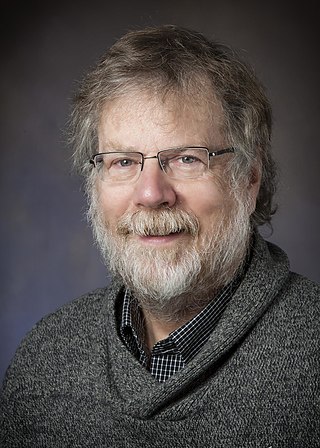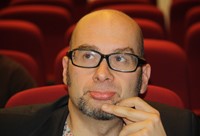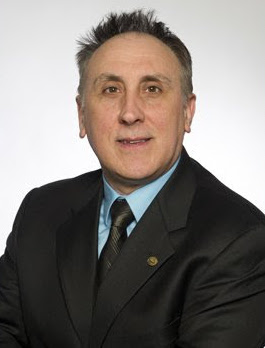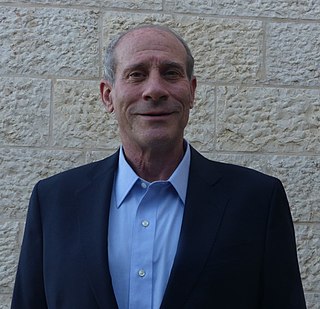Oleg Sushkov is a professor at the University of New South Wales and a leader in the field of high temperature super-conductors. Educated in Russia in quantum mechanics and nuclear physics, he now teaches in Australia.
Harry Leonard Swinney is an American physicist noted for his contributions to the field of nonlinear dynamics.

Marvin Lou Cohen is an American–Canadian theoretical physicist. He is a physics professor at the University of California, Berkeley. Cohen is a leading expert in the field of condensed matter physics. He is widely known for his seminal work on the electronic structure of solids.
Dissipative solitons (DSs) are stable solitary localized structures that arise in nonlinear spatially extended dissipative systems due to mechanisms of self-organization. They can be considered as an extension of the classical soliton concept in conservative systems. An alternative terminology includes autosolitons, spots and pulses.
Quantum dimer models were introduced to model the physics of resonating valence bond (RVB) states in lattice spin systems. The only degrees of freedom retained from the motivating spin systems are the valence bonds, represented as dimers which live on the lattice bonds. In typical dimer models, the dimers do not overlap.

Tendril perversion is a geometric phenomenon sometimes observed in helical structures in which the direction of the helix transitions between left-handed and right-handed. Such a reversal of chirality is commonly seen in helical plant tendrils and telephone handset cords.

Xiao-Gang Wen is a Chinese-American physicist. He is a Cecil and Ida Green Professor of Physics at the Massachusetts Institute of Technology and Distinguished Visiting Research Chair at the Perimeter Institute for Theoretical Physics. His expertise is in condensed matter theory in strongly correlated electronic systems. In Oct. 2016, he was awarded the Oliver E. Buckley Condensed Matter Prize.

David Matthew Ceperley is a theoretical physicist in the physics department at the University of Illinois Urbana-Champaign or UIUC. He is a world expert in the area of Quantum Monte Carlo computations, a method of calculation that is generally recognised to provide accurate quantitative results for many-body problems described by quantum mechanics.
Daniel L. Stein is an American physicist and Professor of Physics and Mathematics at New York University. From 2006 to 2012 he served as the NYU Dean of Science.

Michael Elmhirst Cates is a British physicist. He is the 19th Lucasian Professor of Mathematics at the University of Cambridge and has held this position since 1 July 2015. He was previously Professor of Natural Philosophy at the University of Edinburgh, and has held a Royal Society Research Professorship since 2007.

Jürgen Kurths is a German physicist and mathematician. He is senior advisor in the research department Complexity Sciences of the Potsdam Institute for Climate Impact Research, a Professor of Nonlinear Dynamics at the Institute of Physics at the Humboldt University, Berlin, and a 6th-century chair for Complex Systems Biology at the Institute for Complex Systems and Mathematical Biology at Kings College, Aberdeen University (UK). His research is mainly concerned with nonlinear physics and complex systems sciences and their applications to challenging problems in Earth system, physiology, systems biology and engineering.

Edward Ott is an American physicist and electrical engineer, who is a professor at University of Maryland, College Park. He is best known for his contributions to the development of chaos theory.

Roberto Morandotti is a physicist and full Professor, working in the Energy Materials Telecommunications Department of the Institut National de la Recherche Scientifique. The work of his team includes the areas of integrated and quantum photonics, nonlinear and singular optics, as well as terahertz photonics.

Carlos O. Lousto is a Distinguished Professor in the School of Mathematical Sciences in Rochester Institute of Technology, known for his work on black hole collisions.
In the field of surface growth, there are growth processes that result in the surface of an object changing shape over time. As the object grows, its surface may change from flat to curved, or change curvature. Two points on the surface may also change in distance as a result of deformations of the object or accretion of new matter onto the object. The shape of the surface and its changes can be described in terms of non-Euclidean geometry and in particular, Riemannian geometry with a space- and time-dependent curvature.
William Henry Matthaeus is an American astrophysicist and plasma physicist. He is known for his research on turbulence in magnetohydrodynamics (MHD) and astrophysical plasmas, for which he was awarded the 2019 James Clerk Maxwell Prize for Plasma Physics.
Patrick Mora is a French theoretical plasma physicist who specializes in laser-plasma interactions. He was awarded the 2014 Hannes Alfvén Prize and 2019 Edward Teller Award for his contributions to the field of laser-plasma physics.

John Martin Kolinski is an American engineer. He is a professor at EPFL and the head of the Laboratory of Engineering Mechanics of Soft Interfaces (EMSI) at EPFL's School of Engineering.
Hartmut Löwen is a German physicist working in the field of statistical mechanics and soft matter physics.

Jay Fineberg is an Israeli physicist. He is a professor at The Racah Institute of Physics of the Hebrew University of Jerusalem. He is known for his work on various aspects of nonlinear physics, mainly in the fields of fracture and friction. He is an elected fellow of the American Physical Society and the Israel Physical Society.











